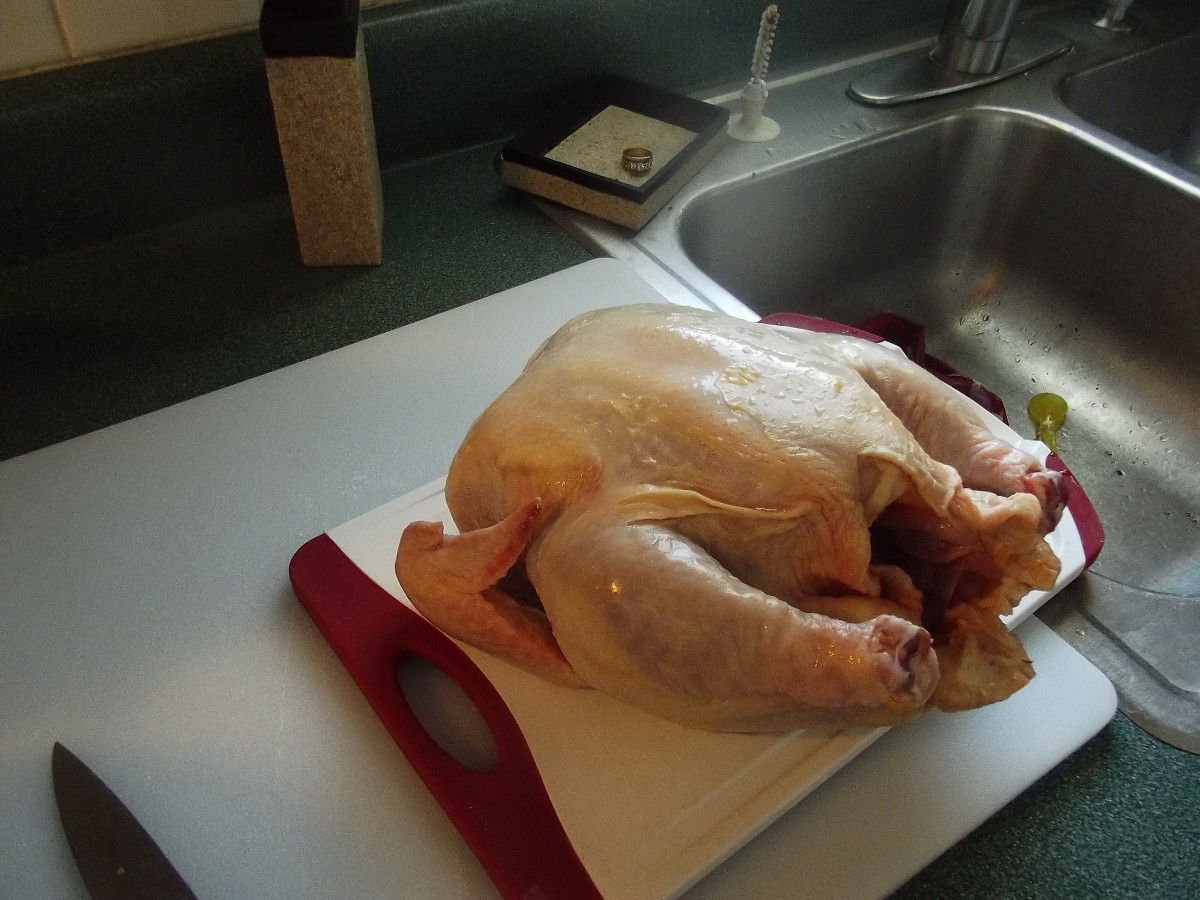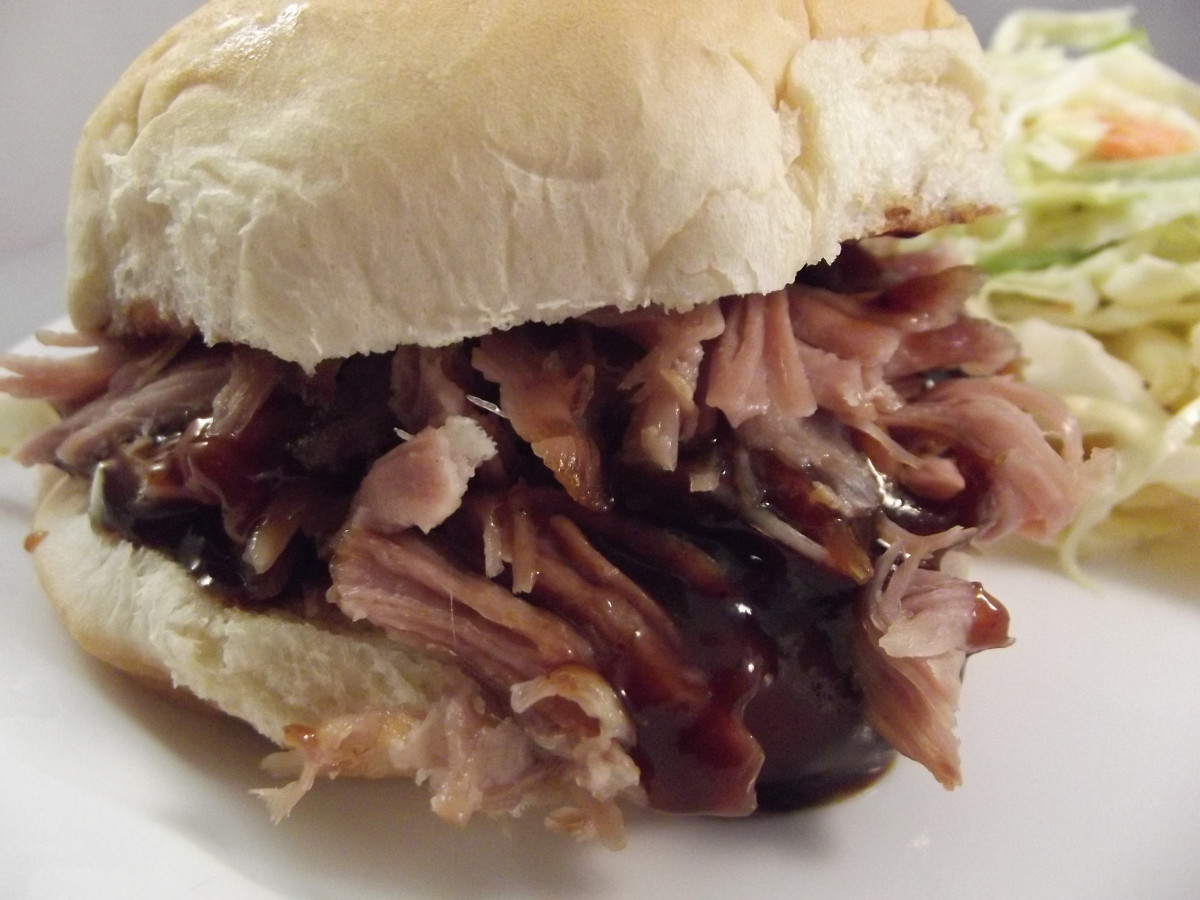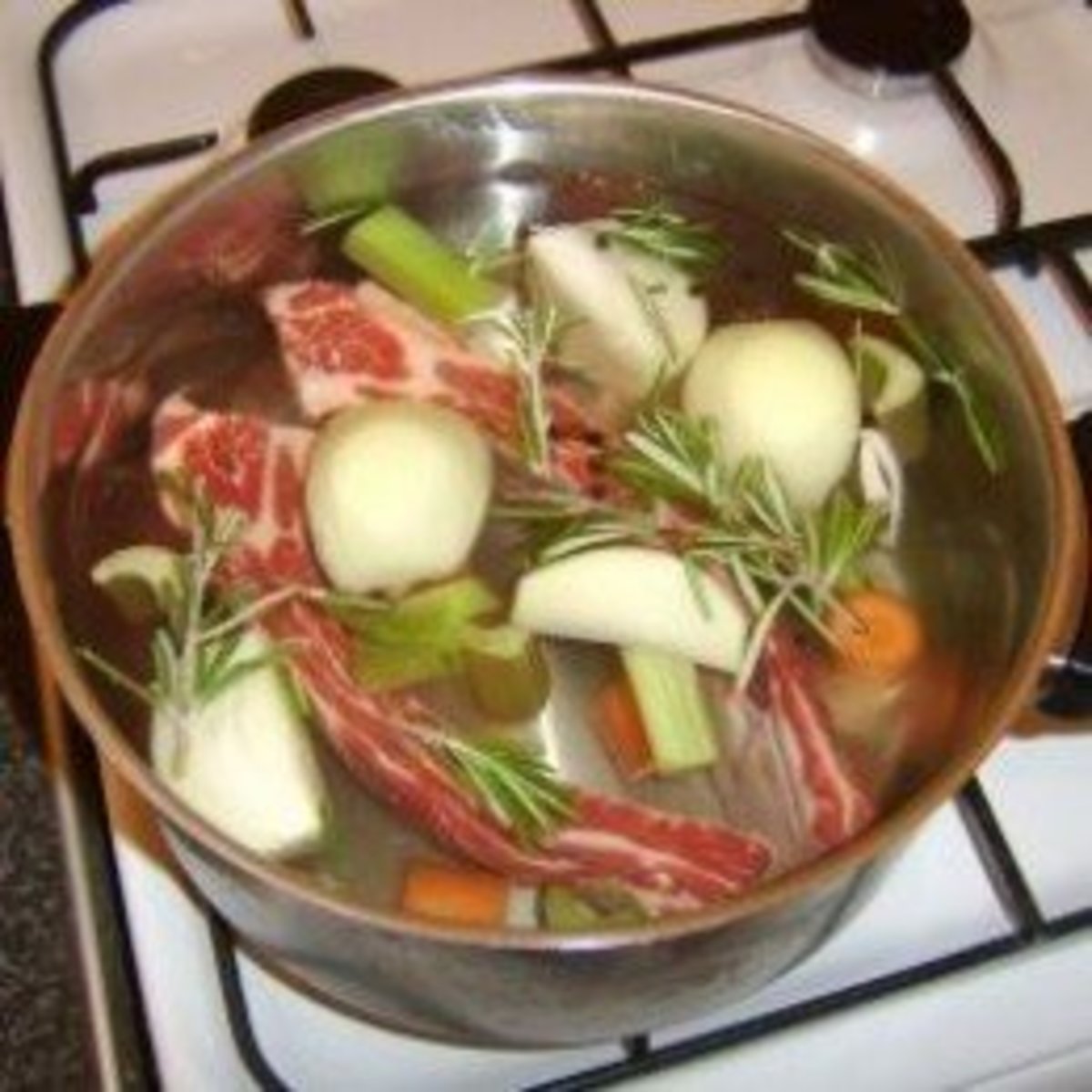Curative Consommé: A Healing Bone Broth Recipe

Real Broth for Real People
Homemade broth is amazing, both by itself or as a base for soups, gravies and stews. Originally called "bone broth" or "broken bone broth," it sounds, well, kind of disgusting. I changed the name to give it a sexy, upbeat connotation, and not sound like a mad science project.
The tastiest liquid you will ever sip from a mug, bone broth provides all the comforts that a hot, steamy cup of broth should give. Beyond its obvious culinary value, however, lies the secret to a greater glory that can only be achieved with patience. Unfortunately, the convenience of canned and cubed bouillon has caused us to forget the value of slow-cooked broth that has simmered long enough to extract the "magic" from the bones, an art that our predecessors understood and practiced by necessity for making broths, soups, stews and gravies. We settle, instead, for relatively tasteless broths, devoid of nutrients, and sometimes full of additives and MSG.
So, what is real bone broth? And why should you bother to make and consume it? Here are some excellent reasons.
Photo Credit: FreeDigitalPhotos.Net

Reason #1: Bone Broth Supports Your Joints
Ever heard of "glycosaminoglycans" (GAGs?) You may know them by their common names, such as glucosamine. Joint health supplements typically include this CAG, and perhaps some chondroitin, too. When you drink bone broth, you get glucosamine, chondroitin, as well as hyaluronic acid, keratin sulfate and other join-boosting CAGs. No need to spend your good money at the pharmacy. Just simmer your old, leftover meat bones and support your joints for free!
Even better, the GAGs contained in bone broth resist digestion. They can be absorbed intact to stimulate cells called fibroblasts, which maintain collagen in the joints, tendons, ligaments, and even the arteries.

Reason #2: Bone Broth Heals Your Belly
Tummy troubles are a very real and widespread issue in our society. What used to be taboo to bring up in conversation -diarrhea, constipation, and gas- are now discussed openly. Products to treat these conditions are advertised heavily, while the root causes are often ignored. To add to the list of offenders, stress, processed foods, poor diets, prescription and OTD drug use, and other of realities modern life can cause the intestinal lining to become "hyperpermeable" -allowing undigested food and toxins to pass unimpeded into the bloodstream. This causes the immune system to react, sometimes violently. No wonder food sensitivities, leaky gut syndrome and autoimmune diseases are becoming commonplace.
Bone broth to the rescue!
Just like jiggly Jell-O, bone broth contains gelatin, a vital nutrient that is often overlooked. Lowly gelatin, in the form of collagen, has the ability to heal and coat the mucous membranes in the gastrointestinal tract. So if you notice that your bone broth gels as it cools, rejoice! You have successfully extracted gelatin from the bones to put to good use in your own body.

Reason #3: Bone Broth Aids Protein Absorption
Speaking of gelatin, did you know that it is rich in amino acids? Our high school science classes taught us in simplified terms that proteins are the building blocks of the body, and that amino acids are, in turn, the building blocks of proteins. Proteins are essentially long chains of amino acids, and although gelatin is not a complete protein in itself, it provides many of the amino acids that are necessary to form proteins.
Consumption of gelatin in the form of bone broth collagen provides the body with necessary amino acids and decreases the amount of complete protein needed by the body. Gelatin also improves the digestion of dietary proteins such as beans, meat, milk, and cheese, making them more accessible to the body. Consumption of gelatin allows the body to reap all the benefits of protein, while ingesting less of it.
Most commercially prepared broths are made from animal skin, which contains one type of collagen. However, bones, ligaments and marrow contain three types of collagen. Preparing your own bone broth gives you the benefits of all types of collagen that are necessary to the body.

Reason #4: Bone Broth Supports a Youthful Appearance
As we get older, collagen levels in our bodies decline, with obvious aging effects. As a society, we spend millions of dollars each year on collagen-enhancing, anti-aging products and treatments. They are expensive, and some are downright weird or dangerous.
You can support the youthful appearance of hair, nails and skin by consuming bone broth, with no harmful side-effects to your body or your bank account. Not only will you appear more youthful and vibrant on the outside, but you will be healthier on the inside, where it really counts!

Reason #5: Bone Broth Supports Detoxification
The liver's job is to detoxify the body, and in our chemical-laden world, it works overtime. But if the liver detoxifies the body, what detoxes the liver? Your liver depends on the amino acid glycine, a precursor amino acid for glutathione. The level of glutathione in the liver is critically linked to its ability to detoxify. The higher the glutathione content, the greater its capacity to detoxify harmful chemicals and toxins, such as alcohol, medications and pollutants. Bone broth provides the necessary glycine required for glutathione production.

Reason #6: Better Teeth & Stronger Bones
Bone broth is an excellent source of calcium and phosphorus. It also contains magnesium, sodium, potassium, sulfate and fluoride. Drinking bone broth replenishes these minerals in our bodies, strengthening bones and teeth.
Just as the stomach uses hydrochloric acid to break down minerals, an acid is needed in order to extract the minerals from the bone. Adding a tablespoon of vinegar or lemon juice when making broth will ensure that the finished product will be mineral dense.

Reason #7: Added Healing Properties of Herbs, Spices & Vegetables
Beyond the benefits provided by the bones themselves, the addition of vegetables and seasonings can increase the health properties of your broth exponentially. Books have been written on the health benefits of veggies, herbs and spices, so I won't rehash them here. However, I will tell you that I generally add kosher salt for trace minerals, ginger to boost immunity, as well as garlic and onions for their antibacterial power. Carrots, celery and other vegetable odds-and-ends are added to the pot for vitamins. The end result is a potent stock that heals the body and tastes delicious!
Do a little research to find vegetables, herbs and spices that will meet your own health needs. A great place to start is Annie's Medicinal Herb Chart.
See also my article Natural Cough, Cold and Flu Remedies, which describes the healing attributes of several herbs.
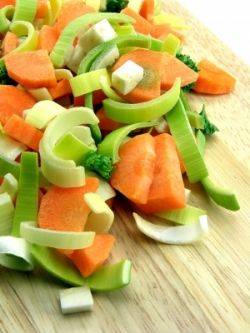
Making Bone Broth is Easy!
The first step is to collect bones and vegetable scraps that you will use the give the broth flavor and nutrition.
Vegetable Scraps:When you chop vegetables or herbs, save the ends and peels in a container in the freezer. Add to it every time you have veggie scraps, discarding any dirty or moldy pieces. Save apple peels and cores, as well, discarding the seeds. When you are ready to make broth, these scraps will be added to the liquid and cooked down to release their vitamins.
Bones: Poultry, fish, beef and lamb bones make the best stock. Whenever you cook these types of meats, save the bones in the freezer for broth. You can also use joints, hocks and shanks for stock. Beef and lamb bones make better tasting stock if there is some meat left on the bones. I prefer to use beef shanks, the cut used for Ossobuco, with the meat intact.
Be sure to start with high quality meats from free range or wild animals. Just like humans, animals that do not exercise have porous, brittle bones that lack proper levels of calcium and other minerals. This will translate into less nutritious stock. On the other hand, free range animals have strong bones that will make excellent bone broth.
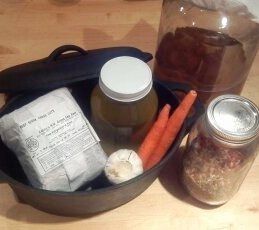
Cook Time
Prep Time: 2 hours
Total Time: 2-3 days
Ingredients
- Beef shank
- sliced into two pieces (have your butcher do this for you.)
- Cooking Oil
- Vegetable Scraps or Fresh Chopped Veggies
- 1 tsp kosher or sea salt
- 2 TBSP apple cider vinegar
- wine vinegar or lemon juice
Instructions
- 1. Place a couple of tablespoons of cooking oil in the bottom of a cast iron or ceramic pot. Place the meat in the pot and rub it around in the oil. Flip the meat over, and rub the underside in the oil.
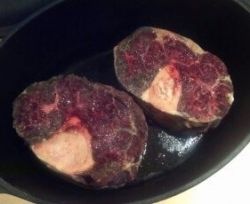
2. Place the open pot in the oven under the broiler with the power on 'high.' Broil until the meat turns very brown, nearly black. Turn the meat over and brown the other side.
3. Once the meat is very brown, put the lid on the pot and place it back in the oven on 375 degrees Fahrenheit. Bake for an hour and a half.
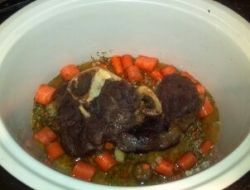
4. While the meat is baking, place the vegetable scraps or fresh veggies, vinegar and salt into a crock pot or slow cooker. Be creative and add your own mixture of herbs and spices. I like to add a few dehydrated vegetables, oregano, basil and thyme flakes, a few garlic bulbs, a chopped onion and a couple slices of fresh ginger root.
5. Remove the pot from the oven and place the meat on top of the vegetables in the crock pot. Deglaze the pot to get the last bits of juicy, meaty goodness out of it. Cover the bottom of the pot with water and place it on a burner set to medium heat. Bring to a simmer, scraping the pan with a wooden spoon to release any meat particles that are stuck to the sides or bottom of the pot. Turn off the heat and pour the water into the crock pot.
6. Add enough cold water to the crock pot to cover the meat. Set the power to "low" and cover with the lid. Allow the broth to cook for 24 hours, adding additional water to keep the meat covered.
7. After 24 hours, remove the meat from the bones. The meat should fall off the bone and practically shred itself. Serve it over rice, noodles or potatoes. It's delicious!
8. Return the bones to the pot, cover with a lid and continue to cook for another 24 hours. Add water, if necessary, to keep the bones covered.
9. Turn off the crock pot and allow the broth to cool. Strain through a sieve to remove all the particles from the liquid. Store in glass jars in the fridge for a few days or in the freezer for several months.
Tips for Better, Easier, Scorch-Free Broth
Tip #1: Bone broth can be made with any kind of bones. Got leftovers from a roasted turkey or chicken? Throw the entire carcass in the pot. Pork, beef, lamb, fish...any kind of bones will work. Just skip the browning part if you have eaten all the meat.
Tip #2: I will sometimes cook a continuous batch for days, adding bones and liquid periodically, and straining off broth as needed. To prevent scorching, I fill the pot entirely with water.
Once the broth reaches a low simmer, I turn the pot temperature down to low and plug the crock pot into a dimmer switch to bring down the temperature even more. Use a candy thermometer to check the temperature and try to keep it between 140 and 150 degrees F. The low temp prevents scorching and preserves nutrients.
Tip #3: Another trick to prevent schorching is to bring the broth to a simmer and then turn of the pot and let it cool. Skim the fat off of the top and store it in the fridge. You can add it back to the broth when it is finished cooking, or use it for for cooking. Turn the crock pot to the low setting and allow the de-fatted broth to cook. Without the fat, it will be less likely to scorch.


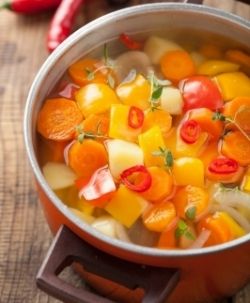
Using Bone Broth
Use bone broth in the place of canned or cubed stock for all your soup stew and gravy recipes. Additionally, I recommend drinking a cup every day, particularly if your immune system needs some support or you suffer from any of the conditions described above.
The recommendations in this article are based on my experience, and are not intended to replace professional medical advice. Do some research on your own concerning the myriad of health benefits attributed to bone broth, starting with the links at the bottom of this article.
Here's to your health!
Be certain to use non-reactive cookware when making bone broth. Cast iron, enamel or ceramic Dutch ovens are safe choices for cooking acidic foods, such as vinegar and lemon juice. Amazon carries a good selection of safe cookware. Qualified orders over $25 ship for FREE with Amazon Super Saver shipping.
Homemade or Canned?
Homemade broth is delicious and extra nutritious, but it takes days to make. Canned stock is more convenient, but lacks the nutrient density of homemade broth.
Which do you prefer? The convenience of canned stock or the nutritional value of homemade broth?
Learn More About Making Homemade Broth and Stock
More information about broken bone broth, as well as other homesteading and DIY skills, is located at the links posted below.
- How to Make Nourishing Traditions Beef Bone Broth Recipe in Stockpot or Crock Pot / Slow Cooker
Having trouble finding Real Food, cultures, books & supplements? Check out my new Resources Page. Thanks for visiting! I've told you before, I'm a bit nuts about making broth. I wasn't always that way but just kind of evolved, as... - How to Make Bone Broth and Bone Broth's Health Benefits
Bone Broth. How to make bone broth steps, health benefits of bone broth, bone broth for leaky gut, bone broth boost immune system, bone broth help digestion... - GAPS Basics: Basic Bone Broth Tutorial: Why and How. | Loving Our Guts
How to make bone broth and why it is good for you.
Have questions or comments? Post them here. If you have a related lens or webpage, free free to post a link. Kindly link back to this lens from your webpage.




